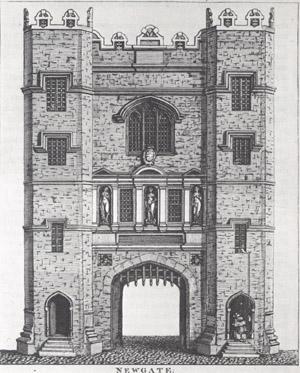
THE Old Bailey was built on the site of the old Newgate Prison, which dated back to the 12th Century. The area has been the scene of floggings, mutilations, pressings (if a defendant refused to plead), burnings at the stake and hangings.
Up to 20 people could be hanged at a time, attracting up to 100,000 spectators. A small bribe to the hangman could ensure a quick death, with him pulling down on the condemned man to ensure the neck snapped without too much suffering.
Newgate Prison was featured in a romatic novel ‘Foreve Amber’ written by Kathleen Winsor (later made into a film). Set in the 17th century, it describes the eplorable conditions and how inmates developed their own prison language called ‘Alsatia cant’.
Local pubs, such as the Magpie and Stump, would hire out rooms offering views of the executions. In 1868 public hangings were abolished due to civil unrest.
There was no specific courthouse in London until 1539. Until then rooms were hired close to the prison to hear cases. The medieval courthouse was destroyed in the Great Fire of London in 1666. In 1673 the Old Bailey was rebuilt as a three storey Italianate brick building.
In front of the courthouse was the Sessions House Yard, a place where litigants, witnesses and the personnel of the court could gather. The area inside the wall, where prisoners awaited trial, was called the bail dock. They were separated from the street by a brick wall with spikes on top to prevent escapes. The court was rebuilt again in 1770-8, destroyed by riots, and rebuilt once more in 1780-3.
The cells were riddled with disease and inmates were serviced by a stream of prostitutes. Pets and livestock were also allowed inside. Hundreds of men, women and children were deported to the United States and later Australia for petty crimes like pick-pocketing.
By the 18th Century Newgate was crowded, filthy and unhealthy. In 1750 the Lord Mayor, two judges, an alderman, an under-sheriff and 50 members of the public attending the sessions house died from ‘gaol fever’ (typhus).
Judges were forced to carry nosegays of flowers to hide the unpleasant smells from the cells. It was believed that disease came from horrible smells and the scent of flowers would offer protection. The tradition of judges carrying flowers still continues today during formal, ceremonial occasions.
The 1834 Criminal Court Act established the Old Bailey as the principal court for London and the South East circuit.
The courthouse takes its name from Old Bailey, the road that runs in front of the court.
In 1902 the old sessions house and Newgate Prison were demolished to make way for the current building, which was opened in 1907 by Edward VII.
The oak-panelled courtrooms have been the setting for some of the most notorious cases in world criminal history. Some famous past trials include that of Oscar Wilde, who was tried for homosexuality in 1895; Dr Crippen, who appeared for the murder of his wife in 1910, and Peter Sutcliffe, the ‘Yorkshire Ripper’, who was jailed for life in 1981. More recently Soham murderer Ian Huntley and millionaire author and politician Jeffrey Archer have faced their days of justice at the Old Bailey.
The statue on top of the Old Bailey is a representation of the Greek goddess Themis. She is the personification of the divine law of right, which ought to control all human affairs. The sword she holds is the sword of state and the scales of justice represent balance in her decisions.





Be the first to comment